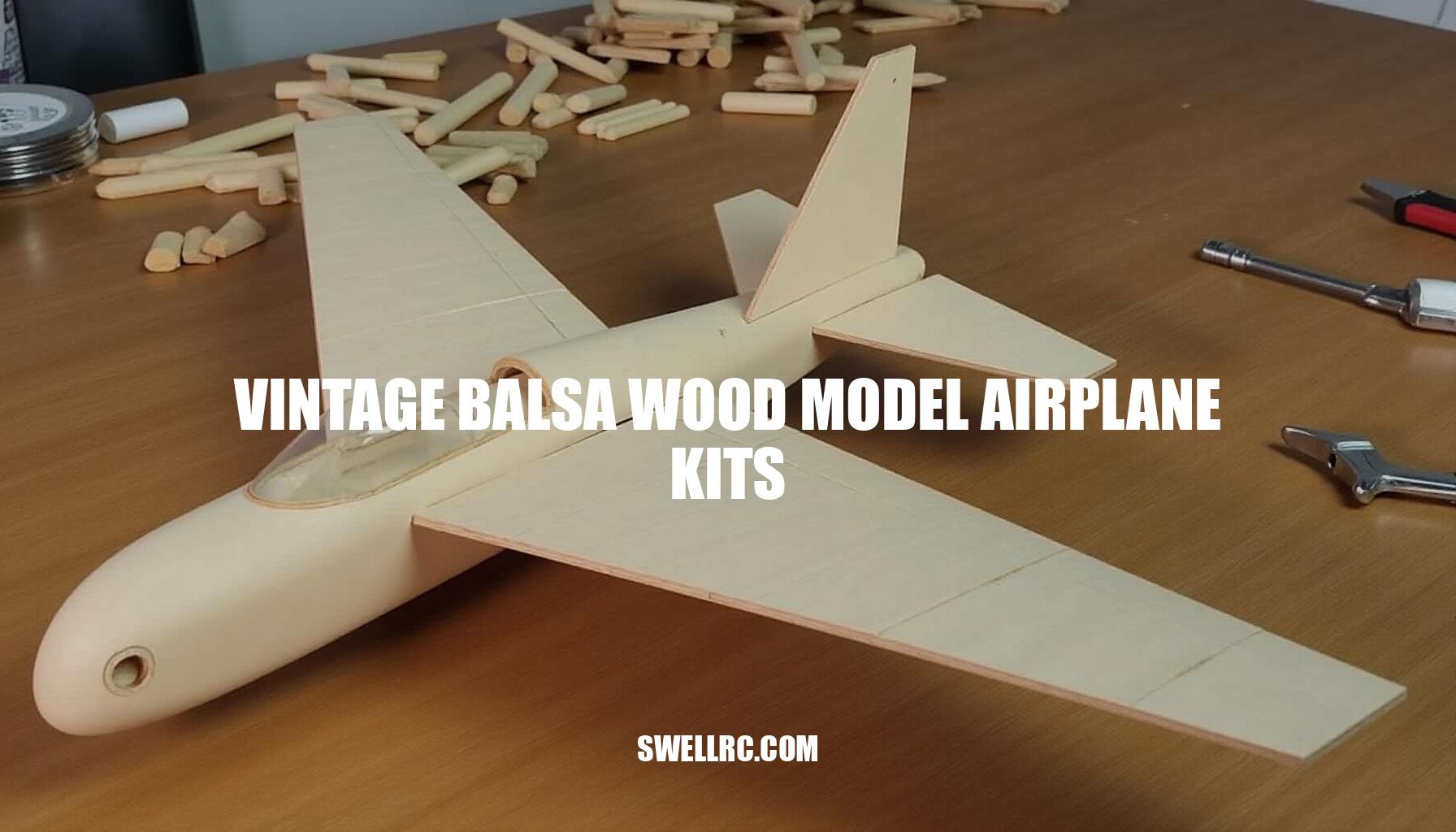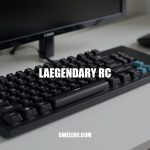The Timeless Allure of Vintage Balsa Wood Model Airplane Kits
A few summers ago at a club swap meet, I spotted a sun-faded yellow box under a table—the kind with die-crunched sheets and that unmistakable balsa-and-dope aroma. I took it home, lifted the brittle tissue paper, and was instantly back to my first successful three-channel flight, hands shaking as a .25 glow engine sang down the runway. That’s the magnetism of vintage balsa wood model airplane kits: they aren’t just projects; they’re time machines.
Balsa is special because it’s ridiculously light for its stiffness, sands like butter, and invites craftsmanship.
When you shape a rib, jig a straight spar, or true a fuselage, you’re literally building flight one stick at a time. And today—thanks to maker culture, slow-build therapy, and a thriving RC airplane hobby community—interest in vintage RC planes and vintage balsa wood model airplane kits is soaring again. If you’re browsing what’s out there, I often start with curated roundups like https://www.swellrc.com/vintage-rc-model-airplane-kits/ for inspiration and market bearings.
These collections capture the nostalgia and craft of aircraft model building, showcasing balsa wood planes that deliver the joy of glow engines and the classic tissue and dope finish.
The Heritage and Appeal of Vintage Balsa Kits
Post-war model aviation blossomed with innovations like free-flight and control line, and then soared higher with the advent of more compact and reliable RC gear. The heritage of balsa kits from this golden age is characterized by meticulous craftsmanship—hand-cut ribs, custom airfoils, and honest structures designed to perform flawlessly when built with care. Brands such as SIG model kits became pillars for generations of enthusiasts, offering approachable yet durable designs that invited hands-on building and flying.
For instance, the SIG lineage showcases this rich tradition of quality and buildability. Meanwhile, the Great Planes Ultra Sport set new standards for smooth aerobatics and versatility, cementing itself as a benchmark in vintage pattern planes history; its planform is still unmistakable at flying fields today (discover its story here).
These classic RC kits endure not just because of nostalgia, but due to the inherent craftsmanship embedded in every phase of their design and assembly: true spars providing structural integrity, precisely set incidences ensuring stable flight, light yet robust sheeting, and the sheer satisfaction derived from a flawlessly ironed covering. Compared to many modern Almost-Ready-to-Fly (ARF) models, vintage kits demand more patience and skill but reward builders with unmatched pride and unique personality.
Below is a table summarizing key differences between vintage classic RC kits and today’s ARFs, illustrating how the experience has evolved without losing its soul:
| Aspect | Vintage Classic Kits (e.g., SIG Model Kits, Ultra Sport) | Modern ARFs |
|---|---|---|
| Part Fabrication | Hand-cut ribs and components, custom airfoils, artisan craftsmanship | Laser-cut parts, die-crunched or molded components for uniformity |
| Wood Selection | Premium balsa and spruce, carefully hand-selected for strength and weight | Pre-cut, mass-produced wood or composite materials |
| Hardware Quality | Robust, often metal, with focus on longevity and serviceability | Lightweight, sometimes plastic, optimized for ease of assembly |
| Adhesives | Traditional wood glues, CA, and epoxy; requiring skillful application | Pre-glued components or quick-setting adhesives, less tolerance for errors |
| Build Time | Lengthy, hands-on process fostering deeper engagement | Shorter, designed for quick assembly and flying |
| Flight Character | Responsive, with a blend of stability and aerobatic capability delivered by honest structure | Stable and forgiving, optimized for broad pilot skill levels |
Embracing vintage classic RC kits is embracing a tradition that values the hand of the builder as much as the joy of the flight. Whether it’s the enduring designs from SIG or the iconic Great Planes Ultra Sport, these models continue to inspire with their blend of engineering elegance and authentic, tactile building experiences that modern kits often bypass. This balance of craftsmanship and performance keeps the spirit of post-war model aviation alive and thriving.
Essential Craft and Building Techniques
When learning how to build a balsa wood RC airplane, following tried-and-true building techniques is essential for a successful project. Start with an inventory and dry-fit phase by carefully checking every sheet, stick, and hardware bag, and dry-fitting bulkheads and formers before applying any glue. Establish true foundations by pinning the plan under wax paper and using a straightedge, squares, and magnets or T-pins to keep spars, longerons, and leading edges perfectly straight.
Understanding the right tools and adhesives is critical. Use aliphatic resin for sandable joints, thin CA for tack and cap strips, and epoxy where loads concentrate, such as firewalls and landing gear blocks. Precise wing alignment ensures proper flight characteristics; jig the washout, confirm dihedral with gauges, and re-check incidence after sheeting.
Sanding and gluing demand discipline—always block sand using progressively finer grits, letting the block, not your wrist, define the airfoil shape. For covering balsa wood model airplanes, whether using traditional tissue and dope or modern film covering, proper surface preparation, dust control, and perfect edges are vital. Employing correct heat and film tension during covering greatly impacts both the finish’s look and longevity.
To give you a compact overview, here is a suggested tool and adhesive checklist for your model airplane build:
| Category | Items |
|---|---|
| Building Board & Jig | Building board or magnetic jig, T-pins/magnets |
| Cutting Tools | Razor saw and sharp blades |
| Sanding Tools | Sanding blocks |
| Measurement Tools | Incidence meter, triangle squares |
| Adhesives | Aliphatic resin, thin/medium CA, 5–30 min epoxy |
| Covering Equipment | Heat iron and gun, covering films or tissue, dope or clear coats |
| Dust Control | Good vacuum for dust control |
For detailed guidance on covering balsa wood model airplanes, including both tissue and dope and film covering techniques, visit this comprehensive resource. Additionally, if you want a cradle-to-maiden walkthrough covering radio setup, hinging, pushrod geometry, and CG management, check out this companion guide.
Selecting and Restoring Authentic Vintage Kits
Authenticating vintage kits is half the fun when restoring old balsa model airplanes. Key indicators like the original box and paperwork—featuring period logos and non-barcoded price tags—are excellent signs of authenticity. Plans often include watermarks or print shop marks, while the instructions display period typography and detailed exploded views, proving the kit’s genuineness.
Wood tells its own story: Die-crunched sheets usually have rounded, slightly crushed edges characteristic of vintage production, whereas reissues tend to be laser-cut leaving dark char marks.
Older balsa wood may appear lighter but can be more brittle, so handle these components with care to maintain integrity.
Kit completeness is crucial for collector value. Ensure all components such as the canopy, cowl, hardware, and decals are present. While replacements exist, having original parts significantly boosts the model’s authenticity and worth.
When restoring these classic kits, my first steps include:
- Quarantine and inspect parts for mold, warps, and fuel residue.
- Gently flatten warped sections using an ammonia/water mist combined with weight or low steam to avoid damage.
- Replace cracked longerons and spars with wood matching the original grain and density to preserve structural integrity.
- Reinforce high-stress areas subtly with light fiberglass or carbon veil without adding noticeable weight.
- Clean glow engine residue using denatured alcohol and reseal any exposed wood surfaces.
- Re-cover or patch damaged areas with period-appropriate materials to maintain the vintage look.
Engines are truly the soul of many classic models.
For period correct glow engines like OS, Enya, Fox, and K&B, I monitor curated listings such as where to buy vintage model aircraft engines. These resources are invaluable for finding the right displacement and mount patterns essential for authentic restoration.
Preservation best practices are vital for longevity. Store sheets and plans flat in acid-free sleeves at 40–55% relative humidity and cool temperatures.
Small parts should be labeled in zip bags with silica gel to prevent moisture damage. Avoid storing models and materials in attic spaces where heat can warp wood and ruin dope finishes.
Exploring Related Vintage Models and Flight Styles
One of my greatest joys in this hobby is chasing different eras through their iconic airframes. Exploring vintage RC pattern planes offers a glimpse into the golden age of aerobatics, where designs reward smooth, axial lines and precise geometry. For inspiration and historical context, I often browse classic models available at SwellRC’s vintage RC pattern planes collection.
Silent soaring presents a different thrill. RC balsa glider kits specializing in thermal and slope soaring teach patience and air-reading skills. Building lightweight models with straight wings dramatically improves lift and flight duration.
I find surveying glider options at SwellRC’s balsa glider kits selection an excellent way to start this journey.
For those craving adrenaline, jet-age speed is unmatched. From the early ducted fans through modern electrics, balsa EDF jet kits capture the look and feel of vintage jets with today’s reliability. These models showcase the evolution in flight styles and can be explored at SwellRC’s balsa EDF jet kits.
Each category serves as a time capsule of aeronautical innovation—a testament that wood, glue, and imagination can keep pace with any era’s ambitions. Whether your passion lies in classic designs, mastering thermal soaring, or pushing the limits with EDF power, these flight styles have something timeless to offer.
Getting Started with Modern Balsa Models
If you’re new or returning to the world of balsa models, modern laser-cut kits serve as the perfect bridge between vintage craftsmanship and contemporary design. These beginner balsa kits combine the charm of traditional wood-shop magic with advancements like laser-cut precision, CAD-true formers, stronger adhesives, and lightweight structures. The rise of electric RC power systems has also improved the building experience by reducing mess and minimizing vibration.
Whether you’re exploring classic reissue kits or diving into innovative modern vs vintage RC airplanes designs, the fundamental joy remains the same — the rhythm of pinning, gluing, sanding, and that exhilarating first flight.
For those seeking some reliable starter recommendations I’ve enjoyed mentoring folks through, consider the following:
- A small RES or 1–1.5 m glider kit, ideal for learning straight builds and mastering light structures.
- A simple three-channel trainer featuring a flat-bottom airfoil, offering forgiving handling perfect for beginners.
- A 35–48 inch sportster or “stick” design suitable for quick, confidence-building aerobatics on a modest electric setup.
My personal tip for an easy “win” is to build laser-cut sportsters with friends. It makes for a fun weekend project — spend Saturday building, Sunday covering, and by sunset, you’re enjoying trimming flights and pure joy in flight.
Conclusion – Why Vintage Balsa Model Airplane Kits Still Fly High
Vintage balsa kits appeal because they transform simple materials into models rich with craftsmanship and character. As you sand the wood, it almost talks back, rewarding your patience and precision. The plans demand careful alignment, and the maiden flight becomes a true achievement, making every effort worthwhile.
These kits are not just nostalgic artifacts; they are a testament to the model aviation legacy, embodying design ingenuity that has stood the test of time.
Practically, they are honest, stable flyers that continue to captivate both collectors and flyers alike. Their collectible and flyable nature means they light up any flightline with the charm of days gone by.
For me, the allure extends beyond the models themselves. The hands‑on learning and vibrant RC community constantly inspire me—there’s always a new trick to test, a classic to restore, or a flight style to master.
If this sparks your curiosity, explore the resources linked above, pick a project that excites you, and join us at the benches. Through shared passion and dedication, the nostalgia and joy of vintage balsa kits keep the spirit of model aviation alive every time we open a box, pin down a plan, and commit to the craft.
Frequently Asked Questions
- What makes vintage balsa wood model airplane kits valuable today?
Scarcity, brand pedigree (e.g., SIG, Great Planes), and high craftsmanship drive value. Collectors prize complete kits with original plans, decals, and hardware. Builders value light, well‑designed structures that fly beautifully. Nostalgia and display appeal add to the market, and period‑correct engines and accessories can increase authenticity and worth. - Are vintage model airplane kits still available for purchase?
Yes. You’ll find them at club swap meets, estate sales, online auctions, specialty hobby shops, and dedicated collector groups. Some classics are reissued with modern laser‑cut parts; these are great flyers, but true vintage boxes with die‑crunched sheets remain the collector favorites. Always verify completeness and condition before buying. - How do I restore or preserve vintage balsa kits?
Control humidity (around 40–55%), store plans flat in acid‑free sleeves, and keep kits away from heat. For airframes, de‑warp gently with moisture and weight, replace cracked members with matching grain, reinforce stress points sparingly, and refinish with period‑appropriate coverings. Clean old glow fuel residue with alcohol and reseal exposed wood to prevent future damage. - What are the differences between modern and vintage RC airplanes?
Modern kits and ARFs use laser‑cut parts, CAD‑accurate geometry, and often electric power, resulting in faster builds and less vibration. Vintage kits typically feature die‑crunched parts, more hands‑on fitting, and glow power. Hardware quality, adhesives, and materials have improved, but the fundamental flight feel and satisfaction of a straight, light build remain timeless. - Which brands make the best balsa wood airplane kits?
Among classics, SIG and Great Planes are standouts for design quality and flying manners. Other respected names include Goldberg, Top Flite, and Guillows. Today, several manufacturers release high‑quality laser‑cut kits and reissues—choose by reputation, plan clarity, wood selection, and community build logs rather than brand alone. - How can you tell if a model airplane kit is truly vintage?
Look for period box art, no UPC or modern barcodes, die‑crunched (not laser‑charred) parts, yellowed plans with older print styles, and original hardware/decals. Reissues often include laser‑cut sheets, updated logos, and modern instruction formatting. Cross‑check kit numbers and catalogs from the era to verify authenticity.



